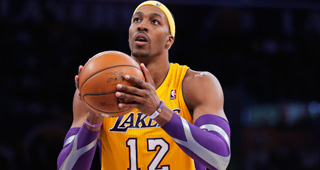Over the past few years, there has been a growing sentiment that defense at the point guard position is of inconsequential importance in the game today.
Proponents of this view point to the plethora of explosive point guards in the NBA today that are bigger, more athletic, and more scoring oriented than those of the past. However, the fact that many modern day point guards can score with ease does not mean that defending the position is no longer important. Talented scorers should highlight the importance of defending rather than diminishing it. Rather than conceding 15-20 points a game, opposing coaches make them work for it, hoping to use various defenders and schemes to force tough shots, and ultimately low conversion rates.
A more popular view is that having a great shot blocking help defender such as Dwight Howard negates the detriment of having a poor defender at the point guard position. This assumption is founded on a very specific situation: the opposing point guard blows by the defensive player, and the center on the defensive end rotates to help and effectively prevent the point guard from scoring.
Although athleticism and timely help defense may be able to prevent the attacking point guard from scoring, getting beat off of the dribble at the top of the key will ultimately result in a 2 on 1 advantage for the team on offense, often leading to a basket.
A perfect example of this is the Los Angeles Clippers. Sure, whenever Chris Paul drives past his defender, opposing post players are able to rotate over to defend him and “negate” the fact that their point guard had just gotten beat. As such, Paul might not score, but that defensive slide from one of the post players to stop Paul leaves a single post player to deal with both Blake Griffin and DeAndre Jordan, enabling the many highlight dunks in Lob City.
More importantly, if the defenders choose to stick with Griffin and Jordan, then they concede an easy lay-in for Paul. The significance of this is that no matter how the defensive post players choose to play the situation, they are in a compromising defensive situation; one that they would be in less frequently if their point guard could contain the opposing one with limited help.
In addition, defending a point guard does not begin and end with beeline drives to the basket from the top of the key initiating basic defensive rotations. Point guards can attack in numerous ways, the most popular method being through the pick and roll or one of its variations.
A recent game between the Utah Jazz and the struggling Los Angeles Lakers served as an example highlighting the vulnerability of a team that has weak point guard play on the defensive end. In the last few minutes of the 4th quarter, the Jazz held a fair lead on the Lakers. Despite an efficient offensive effort from Kobe Bryant, his team failed to close the gap because they couldn’t stop a very simple but effective Utah attack.
Each Jazz possession would begin with Mo Williams choosing a side of the court then calling for a screen. Williams would attack the pick aggressively, forcing Howard to guard Williams while Duhon recovered. Despite Howard’s best attempts, this brief moment was more than enough for Williams to hit either Al Jefferson or Paul Millsap for a low difficulty jumper or lay in. If Bryant or World Peace chose to help instead, Williams hit Hayward or Foye for an open look.
In short, poor defense at the point guard position forced the Lakers into compromising defensive situations where the goal was no longer preventing a good look for the Jazz, but delaying it. What this situation reveals is that no matter how athletic and talented of a help defender a team has, it is not enough to overcome a numerical disadvantage in terms of defensive to offensive player ratios.
It seems that people often forget what the first word is in the phrase “help defense.” Yes, having a great defensive help defender in the post such as Dwight Howard is helpful, but help is not the same as prevent. Once a point guard gets beat, the team is at a numerical disadvantage, rotating to take away the immediate threat of a basket at the cost of conceding a later one. Once a team’s defense is compromised, a basket for the opposing team is likely.
As such, having a point guard that can at the least stay in front of his man and make it tough on defense is at the very least valuable in that it allows his team to play five-on-five defense, with one defender primarily responsible for only one offensive player. Is point guard defense the most important aspect on the defensive end of the game? Maybe, maybe not? However, is point guard defense irrelevant? Far from it. Just ask the Lakers.


